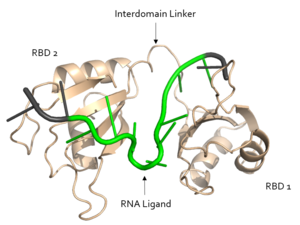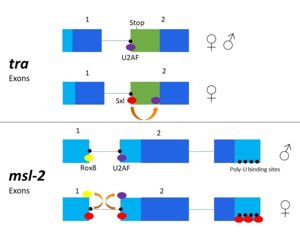User:Mark Macbeth/Sandbox2
From Proteopedia
| Line 6: | Line 6: | ||
== Significance == | == Significance == | ||
| - | [[Image:Sex Lethal Protein Structural Overview with Labels.png|300px| | + | [[Image:Sex Lethal Protein Structural Overview with Labels.png|300px|left|thumb| '''Figure 1.''' Structural overview of Sxl. RNA ligand colored in green is recognized and bound, while RNA ligand colored in grey is not bound. Image created in PyMol. Structure shown is [https://www.rcsb.org/structure/1b7f PDB:1b7f].]] |
The Sxl RNA splicing targets encode for the transformer (''tra'') and the male-sex lethal (''msl-2'') proteins. ''Tra'' is a splicing activator for the female developmental pathway, and ''msl-2'' modulates [http://en.wikipedia.org/wiki/X_chromosome X chromosome] application in male fruit flies. The mechanism for how Sxl targets these pathways differs slightly. In both mechanisms, Sxl occupies the 3' splice site and prevents [http://en.wikipedia.org/wiki/U2AF2 U2AF] from binding. This causes the U2AF splicing factor to bind at a downstream splice site encoding proteins in the female developmental pathway. In ''msl-2'' targeting, Sxl also blocks the binding of another regulatory splicing factor, Rox8, and the [http://en.wikipedia.org/wiki/SnRNP U1 snRNP] at the 5’ splice site<ref name="Penalva">. Sxl can also control its own splicing pattern to conserve female expression. It does so by binding to [http://en.wikipedia.org/wiki/Exon Exon] 3 of its own RNA and creating an RNP complex to eliminate this exon. After removal of Exon 3, Sxl becomes active and female expression is maintained. | The Sxl RNA splicing targets encode for the transformer (''tra'') and the male-sex lethal (''msl-2'') proteins. ''Tra'' is a splicing activator for the female developmental pathway, and ''msl-2'' modulates [http://en.wikipedia.org/wiki/X_chromosome X chromosome] application in male fruit flies. The mechanism for how Sxl targets these pathways differs slightly. In both mechanisms, Sxl occupies the 3' splice site and prevents [http://en.wikipedia.org/wiki/U2AF2 U2AF] from binding. This causes the U2AF splicing factor to bind at a downstream splice site encoding proteins in the female developmental pathway. In ''msl-2'' targeting, Sxl also blocks the binding of another regulatory splicing factor, Rox8, and the [http://en.wikipedia.org/wiki/SnRNP U1 snRNP] at the 5’ splice site<ref name="Penalva">. Sxl can also control its own splicing pattern to conserve female expression. It does so by binding to [http://en.wikipedia.org/wiki/Exon Exon] 3 of its own RNA and creating an RNP complex to eliminate this exon. After removal of Exon 3, Sxl becomes active and female expression is maintained. | ||
Revision as of 17:23, 30 March 2018
| |||||||||||
Additional Reading
For more information on the U2AF splicing factor.
Relevance
As Sxl functions as a splicing repressor, it may give insight into the effects of varying mechanisms of alternate splicing both in flies and other species. Sxl may also lead to understanding of human alternative splicing factors. As an RNA binding protein, research regarding Sxl may contribute to the understanding of enzymes with RNA recognition motifs. The Sxl RNP motif of RBD1 is also conserved in the ELAV family of proteins[1].
References
- ↑ 1.00 1.01 1.02 1.03 1.04 1.05 1.06 1.07 1.08 1.09 1.10 1.11 1.12 1.13 1.14 1.15 1.16 1.17 1.18 1.19 Handa N, Nureki O, Kurimoto K, Kim I, Sakamoto H, Shimura Y, Muto Y, Yokoyama S. Structural basis for recognition of the tra mRNA precursor by the Sex-lethal protein. Nature. 1999 Apr 15;398(6728):579-85. PMID:10217141 doi:10.1038/19242
- ↑ 2.0 2.1 Penalva LO, Sanchez L. RNA binding protein sex-lethal (Sxl) and control of Drosophila sex determination and dosage compensation. Microbiol Mol Biol Rev. 2003 Sep;67(3):343-59, table of contents. PMID:12966139
- ↑ 3.0 3.1 3.2 3.3 . The tra expression pathway only involves the 3' splice site, while the msl-2 pathway involves both the 3' splice site and the 5' splice site. Both mechanisms cause U2AF binding downstream with lower affinity (Fig. 3)<ref></ref>. U2AF is a more general splicing factor than Sxl, and prefers cytidine-containing poly-uridine pre-mRNA sequences, so Sxl binds to the guanosine-containing pre-mRNA with a 104-fold greater affinity<ref></ref>.
Autoregulation
Sxl is capable of autoregulation of its expression<ref></ref>. The Sxl gene is transcribed in male flies, but the inclusion of exon 3 results in a premature stop codon, producing an inactive, truncated protein. The same Sxl promoter is active in female flies, but an additional (briefly active) Sxl promoter produces a transcript with exon 3 removed, resulting in an active Sxl protein which will initiate other female-specific splicing cascades<ref></ref>.
Tra
In alternative splicing of the tra gene, Sxl binds at the 3' poly-uridine site (Fig. 3). This causes U2AF to bind downstream and the spliceosome transcribes the following exon<ref></ref>. In the absence of Sxl, the normal gene for male development is transcribed. The exon contains a stop codon which results in a truncated, non-functional protein<ref></ref>. In the presence of Sxl, this exon is spliced, so the stop codon is skipped<ref></ref> (Fig. 3). This enables translation of an active tra protein<ref></ref>.
Msl-2
The alternative splicing of msl-2 is reliant on Sxl binding to both the 5' and 3' splice sites (Fig. 3). Sxl binds at the 3' splice site, replacing U2AF as in tra splicing. Sxl also competes with Rox8, which binds to the first intron. As a result, Sxl prevents splicing of the first intron of the msl-2 primary transcript. Sxl also binds to the poly- U sequences of the 3' UTR to repress translation (Fig.3)<ref>doi:10.1128/mmbr.67.3.343-359.2003</li></ol></ref>


